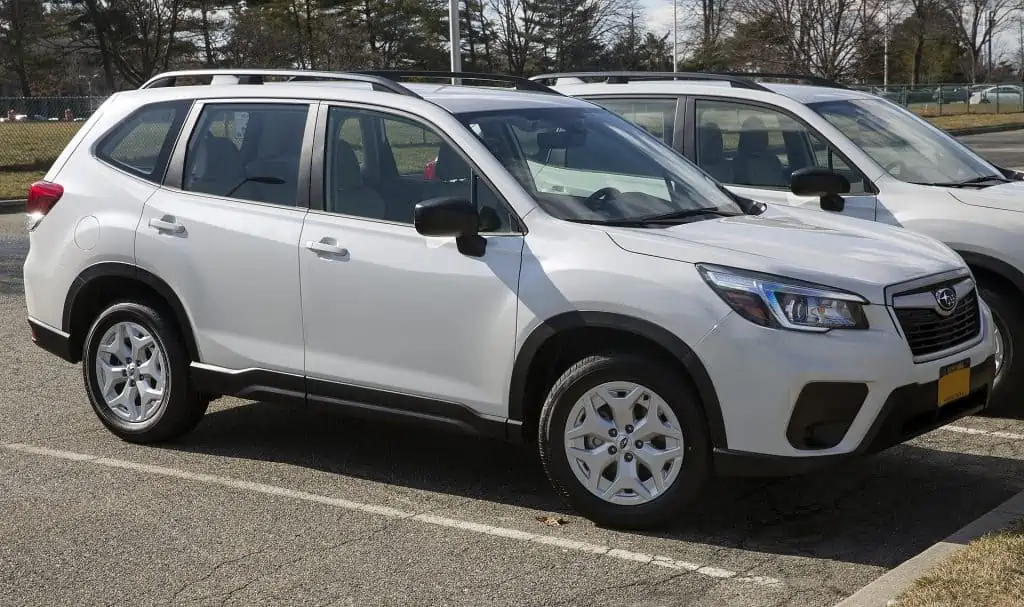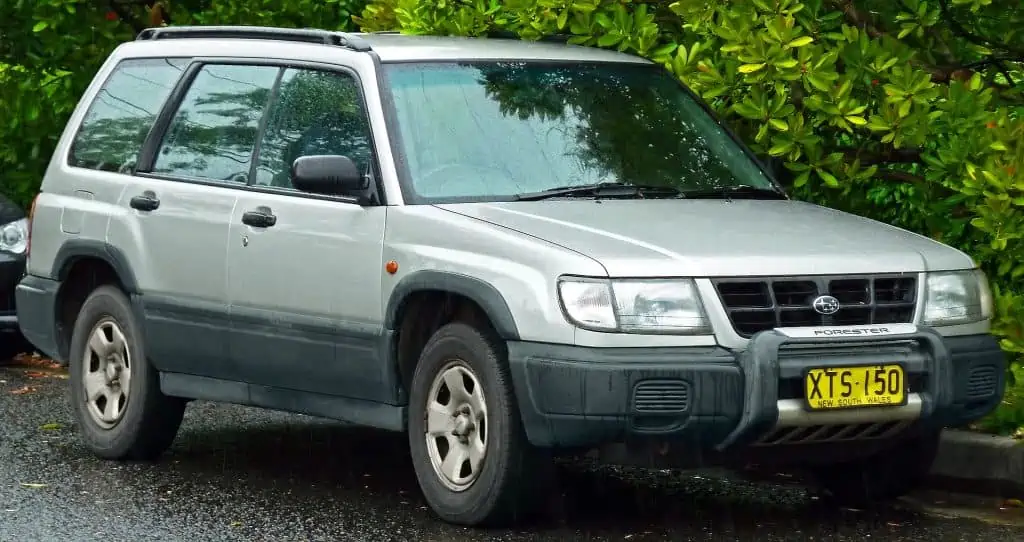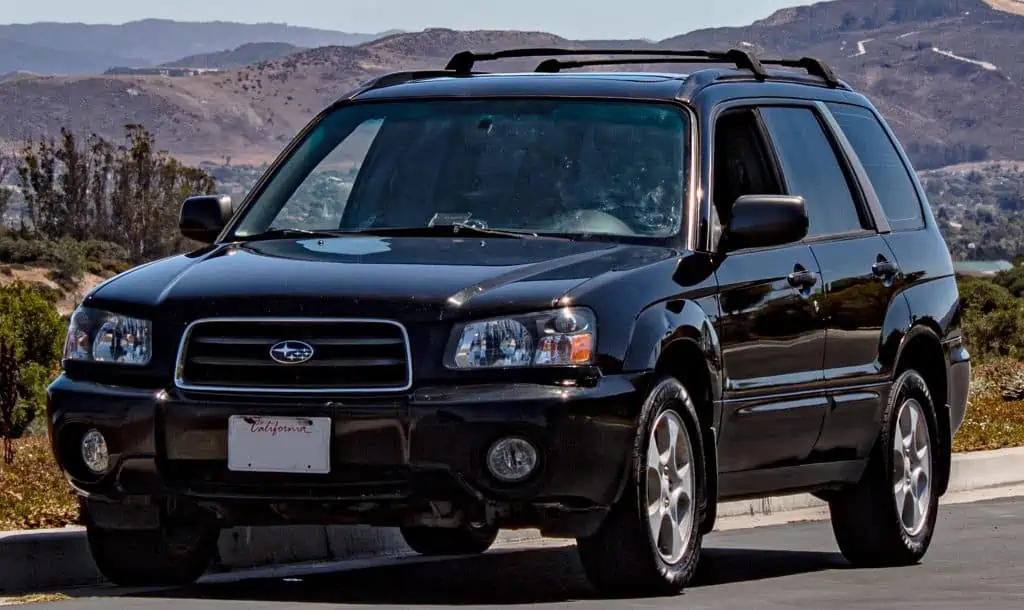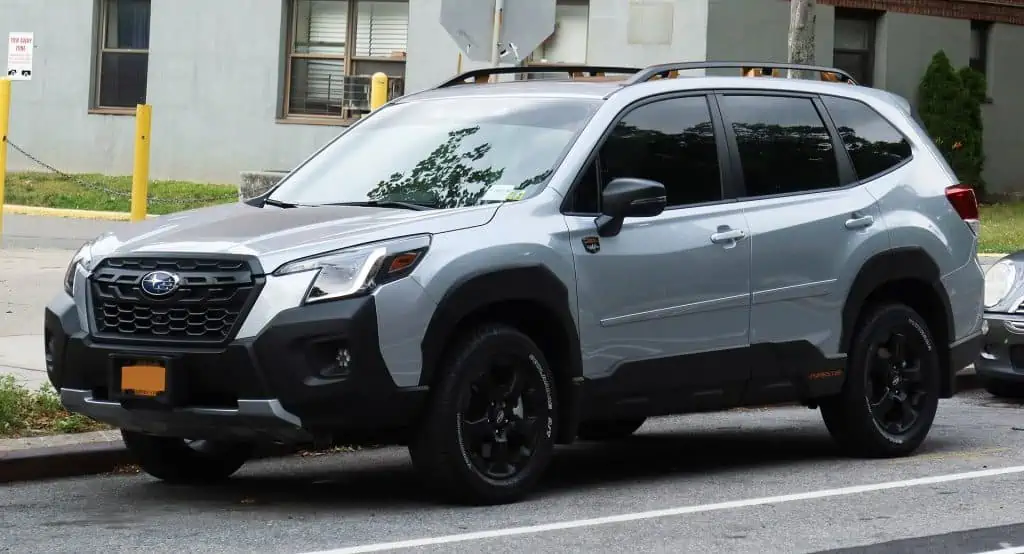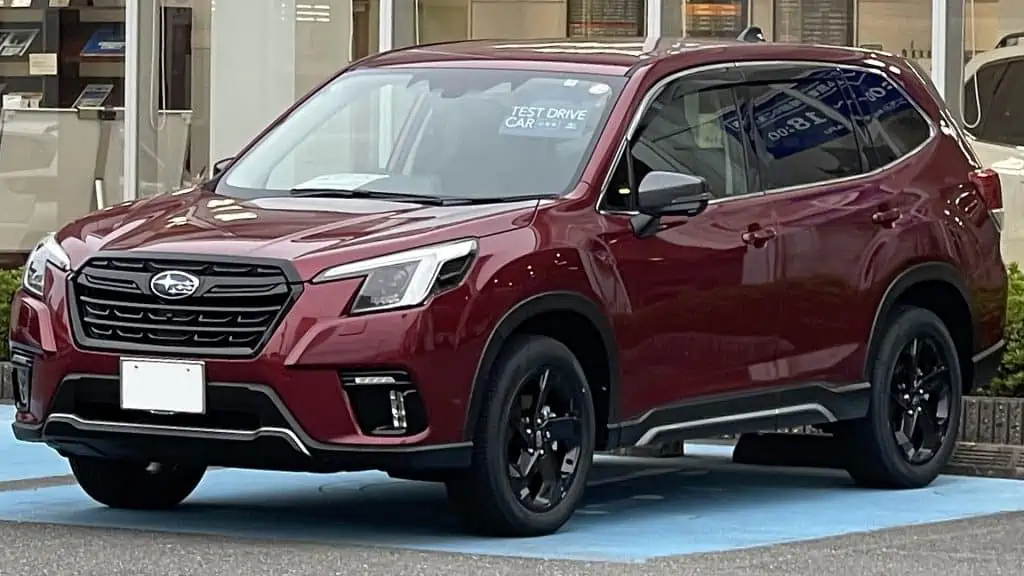The Subaru Forester is one of the most well-liked automobile models available today. Despite having a high popularity rating, Forester still has a lot of issues that need to be resolved before buying a car.
In 1997, Subaru unofficially based its Forester crossover on the Impreza. The Forester’s boxy design and gritty aesthetic would come to be associated with the car, and its low profile makes it stand out from its rivals.
When it was originally introduced, the new Forester fitted comfortably between the Impreza and the Legacy. Despite being a popular brand with some of the most devoted drivers, it nevertheless has ongoing problems. Which Forester model years should you stay away from?
The worst model years are 2003 through 2015, with the 2014 and 2015 Forester issues being the most alarming.
Which are the Subaru Forester Years to Avoid?
The top three Subaru Forester issues cover the 2011 to 2014 model years. The 2014 Forester’s damaged coil springs are the third-worst Forester problem, and repairing them often costs $1,000. Excessive oil consumption in the 2011 Forester is the second-worst Subaru Forester issue, and the average cost to remedy it is $1,600.
2020 Subaru Forester by Mr.choppers / CC BY-SA 3.0. The 2020 Forester is yet another superbly crafted SUV with a spacious cabin, excellent fuel economy, and a wealth of standard safety features.
High oil consumption in the 2014 Subaru Forester is the biggest issue, with a typical service costing roughly $2,000 and typically happening around 26,000 miles.
The following are the Subaru Forester years to avoid buying:
- 1998 to 2001
- 2003
- 2006
- 2009
- 2010
- 2011
- 2014
- 2015
- 2017
There are valid reasons to avoid each of these Forester model years, despite how numerous there may appear to be. According to conventional wisdom, redesign years should be avoided so that the revised models have time to iron out any kinks. However, such redesign years include 2002, 2008, 2014, and 2019.
In actuality, however, only the 2014 redesign model had serious problems. With a few exceptions that had just too many issues, the others are mostly from the first and second generations.
The Subaru Forester Years to Avoid: First Generation 1998 to 2001
The most serious gasket head issues were present in the Foresters from 2001 and before, with 1998 being the worst of the first-generation cars. A single-layer head gasket was inadequate at the root of the issue.
Nearly all Foresters from this era had head gasket leaks, which typically occurred after 50,000 miles. All things considered, this isn’t too awful, but consistent enough that you may want to avoid all first-gen models. New models can have their share of faults.
The Subaru Forester Years to Avoid: 2003
The windows and windshield, seat belts and airbags, as well as the body and paint categories, are among the top user complaints for the 2003 Subaru Forester. The NHTSA’s principal worries centered on the engine and fuel system.
Breaking door seals and wind noise from the window seal are the two most prevalent Subaru Forester difficulties for this year, both of which are rather simple and resolvable. The only real solution for this was to effectively replace the door; otherwise, you can get problems with the power window not rolling up. This is an irritating issue that shouldn’t be affecting drivers with today’s technology, even at the claimed 80,000-mile threshold. The seal replacement, which costs around $400, is the normal repair cost for the loud air noise.
Two of the most frequent consumer complaints concerning seatbelts and airbags are the airbag light turning on and the airbag failing to deploy. These problems often arise at 60,000 miles and are classified as having a severity of 3.0 out of 10. 2006 The head gasket failing, the automobile misfiring when accelerating, and the engine dying are the three main issues with your Subaru Forester’s engine system. abrupt decrease of power causing braking.
The Subaru Forester Years to Avoid: 2006
The engine category, the windows and windshield category, and the transmission system are the top Subaru Forester issue categories for this model year.
The biggest problems with the Subaru Forester’s engine system revolve around the head gasket failure, the engine misfiring when accelerating, the engine failing, the engine firing, the engine surging while braking, and the vehicle losing all power.
1998 Subaru Forester by OSX. The Foresters from 2001 and before had the most severe gasket head problems, with 1998 being the worst of the first-generation vehicles.
When the head gasket fails at over 78,000 miles, the normal repair fee is in the neighborhood of $1,800.
The Subaru Forester Years to Avoid: 2009
The engine, interior accessories, and the A/C and heating system are among the top 2009 Subaru Forester issues.
The most serious Subaru Forester faults to be fixed are timing belt pulley failure, engine failure, head gasket leaks, excessive oil consumption, and rod banging. The most typical fix for engine failure, which typically occurs at about 112,000 miles, is to replace the complete engine.
The compass not working, the driver’s seat collapsing, and the key lock-in not functioning properly are the three primary interior accessory issues with the 2009 Subaru Forester.
The Subaru Forester Years to Avoid: 2010
With the Subaru Forester issues, especially the engine system, the 2010 Forester was one of the worst model years to date. The Forester’s brake system and interior accessories.
The most frequent engine issues reported by 2010 Forester customers were blown head gaskets, engine failure, noisy cold starts, blown turbo engines, and the diesel filter warning light coming up while driving. Blown head gasket repairs typically cost $2,380 to replace the head gasket at 91,000 miles. The driver’s seat collapsing, the compass not functioning, and the crucial lock-in malfunctioning is the main problems with the inside accessories.
The seat collapsing, the hatch arm breaking and the check engine light appearing on the dashboard while driving are the inside accessories of the 2010 Forester that receive the most criticism. The only solution to the seat collapsing at around 64,000 miles is to install a new seat.
The Subaru Forester Years to Avoid: 2011
The main customer complaints to the NHTSA and faults with the 2011 Subaru Forester were on the engine system and the brakes.
2011 Subaru Forester engine problems include excessive oil consumption, engine failure, oil leaks, burnt oil odor, and sudden acceleration. These flaws were far worse for the 2014 model, but they started to become serious difficulties for consumers this year. The most common remedy for high oil consumption is replacing the engine or adding oil; this repair typically costs $1,640 and happens approximately 46,000 miles.
The Subaru Forester Years to Avoid: 2014
The 2014 Forester model is the one to stay away from. This was one of the worst model years because of the numerous engine failures, high oil consumption, suspension issues, and gearbox issues.
Suspension: While a bad suspension is awful, when it’s coupled with gearbox issues, it’s even worse. The majority of suspension problems in 2014 were determined to be caused by broken coil springs. Spring, strut, and rear coil spring replacements typically cost roughly $1,200 and were common after only 50,000 miles.
Vehicle surging, a damaged clutch, a car rolling backward when it is parked, and becoming stuck in the park are the most typical gearbox issues. These issues were primarily resolved by the manufacturer and dealers, who were most familiar with defective issues.
Electrical: The year 2014 is at the top of the list of Forester model years to avoid, with several electrical problems, blown fuses, and warning message lights. Even though they aren’t the most expensive solutions, anytime there is one electrical issue, there are generally many more that require addressing.
2003 Subaru Forester by LukaCali / CC BY-SA 4.0. One notable problem is the faulty gearbox parking rod on the 2002–2003 Subaru Forester. It would be unable to activate when in “park,” which might cause the car to roll or move erratically.
The Subaru Forester Years to Avoid: 2015
Due to the significant amount of complaints received overall for this year, the 2015 Forester is frequently recognized as the worst car. The engine, interior accessories, and transmission are the Subaru Forester 2015 issues that need the greatest attention.
The most common engine problems reported by 2015 Forester owners are excessive oil consumption, sudden acceleration, engine stalling while driving, the check engine light remains on, engine resistance when accelerating, and the engine catching fire or malfunctioning.
With the 2015 model year, interior accessories are still available. Speech recognition had issues understanding commands, especially when driving, and Bluetooth connectivity was sporadic and difficult to operate on demand. The quickest option was to replace the radio with a new one, which would generally cost between $150 and $250 to fix, even if these two issues don’t necessarily affect the car’s ability to drive.
The Forester’s engine and transmission are another set of standard repetitions. The gearbox failing, sliding and experiencing a delay while turning on the ignition were issues for the 2015 model year, as well as surging at low speeds.
The Subaru Forester Years to Avoid: 2017
The 2016 Subaru Forester had a reasonably trouble-free year, but the 2017 Forester received more serious concerns that need to be addressed right now. The gearbox, electrical system, and engine are the main areas of concern for the 2017 Forester.
The gearbox is the key area of concern for 2017 Subaru Forester troubles, and the primary customer complaints include jerking and shaking when driving.
The penultimate year before the most recent overhaul, 2017, had fewer troubles than the years before it, but it was still not without its share. The battery was weak, the radio and navigation system frequently froze, and drivers were sometimes left stranded while traveling due to the battery life. As early as 25,000 miles, the battery failed, and stalling has been experienced throughout the vehicle’s lifespan.
The Subaru Forester’s primary engine-related issues for the 2017 model year are excessive oil consumption, unexpected acceleration, and stalling when accelerating. The average mileage at which excessive oil consumption has to be fixed is close to 16,000 miles, with a severity score of 6 out of 10. The Forester didn’t get much better after this year, though it wasn’t the worst.
Which are the Greatest Subaru Forester Model Years That You Should Consider Purchasing?
The following Subaru Forester model years are safe to buy since they have very few customer complaints:
- The Subaru Forester Best Year 2019
- The Subaru Forester Best Year 2020
- The Subaru Forester Best Year 2021
The most current model years are the finest to look at if you’re wanting to get a Forester, even if it has been well-liked since it was first released. These models have high safety ratings, better connectivity and technology, and positive user evaluations. These three are sure bets, though it may still be too soon to tell if they will experience the same long-term problems as their predecessors.
The Subaru Forester Best Year: 2019
For buyers looking for an all-wheel drive crossover SUV, the 2019 Forester has a lot to offer. It features a roomy interior, a smooth ride, and quick handling. Along with being anticipated from a Subaru, all-wheel drive is also standard.
2006 to 2008 Subaru Forester XT Sports by IFCAR. The most common Subaru Forester problem categories for the model years 2006 to 2008 are the engine, windows and windshield, and transmission system.
The 2019 Forester has a few, albeit small, dependability concerns that warrant attention. The windshield’s propensity to chip readily, even with a low-mileage car, is its main gripe.
The Subaru Forester Best Year: 2020
Another expertly made SUV with a big cabin, great fuel efficiency, and a ton of standard safety equipment is the 2020 Forester. The segment’s best all-wheel-drive system, the base model performs as promised.
Concerning dependability issues, the windshield of the Forester tends to fracture quickly, which is the major source of the complaint. The SUV’s electrical system is also problematic, particularly with the sporadic power liftgate that opens without warning.
The Subaru Forester Best Year: 2021
The 2021 Forester, another lauded SUV from Subaru, epitomizes toughness and usefulness.
The Forester isn’t the most eye-catching SUV on the market, but its practicality more than makes up for it. It’s difficult to go wrong with the 2021 Forester thanks to its ample interior room, fantastic EyeSight driver assistance system, and top-notch AWD system.
The Top Rated Subaru Forester Reliability
The Subaru Forester’s dependability ratings for the top years are as follows:
The Subaru Forester Rating for the 2019 Model Year
The issues with the 2019 Subaru Forester have significantly improved from the model years that received bad ratings in 2014 and 2015. The 2014 Forester’s advantages include a classy and sumptuous interior, functional and simple features, outstanding safety ratings, and a comfortable ride for extended durations. This model year’s Subaru Forester only has two issues: a weak engine, and slow acceleration.
For its outstanding attributes, this model year has received several rankings and accolades. The 2019 Forester ranked #9 in the category for 2019 Affordable Compact SUVs, #11 in the category for Used Compact SUVs $20K and up, #15 in the category for 2019 Affordable SUVs with 2 Rows, and #24 in the category for Used SUVs with 2 Rows $20K and up.
In the 2019 Affordable Crossover SUV and Used Crossover SUV within the $20 and $25K categories, respectively, the #26 and #32 spots are the sole negative rankings and middle-of-the-road scores.
The Subaru Forester Rating for the 2020 Model Year
Despite the Subaru Forester’s issues in recent years, this model’s 2020 Forester scored in the center of the pack for small SUVs. This model year features a roomy cabin, innovative and user-friendly technology, numerous safety features, and good fuel efficiency.
The positives of this 2020 model year include roomy interior space, an all-wheel drive, outstanding fuel efficiency, and a smooth, pleasant ride. The Subaru Forester has a weak acceleration, low expected dependability, and other issues for the 2020 model year.
The critics’ rating for this model year is 8.6, the performance rating is 7.1, the interior rating is 8.1 out of 10, and the safety rating is 9.8 out of 10, giving it a US News Scorecard score of 7.8 out of 10.
Additionally, the 2020 Forester was named a finalist for both the Best Compact SUV for Families and Best Compact SUV for the Money awards.
The Subaru Forester Rating for the 2021 Model Year
The Subaru Forester still ranks #9 in the Compact SUV category despite its issues. Ample passenger and cargo room, a user-friendly infotainment system, excellent fuel efficiency ratings, and all-wheel drive are advantages of this model year. The lowest possible dependability rating and the lack of engine power are the 2021 Forester’s drawbacks.
2005 Subaru Forester STI by User3204 / CC BY-SA 4.0. Among the most common customer complaints about the 2005 Subaru Forester are those regarding the windows and windshield, seat belts and airbags, body and paint, and other safety-related issues.
The 2021 Forester placed ninth in the Compact SUV category, thirty-first in the Crossover SUV category, and twenty-first in the SUVs with two rows. Even with its issues, the Subaru Forester is still rated quite highly and in the center of the pack among small and crossover SUVs.
This model year’s Car US News Scorecard scored 7.7 out of 10, with the critics’ rating of 8.6, the performance rating of 7.1, the interior rating of 7.9, and the dependability rating of just 2 out of 5.
How Much Is the Subaru Forester’s Maximum Mileage?
One of the most well-liked vintage examples of luxury, comfort, and style vehicles is the Subaru. These vehicles quickly gained popularity among everyone who was seeking that specific mix.
It varies and has always been the response to the frequently asked question about how long Subarus survive. However, most of it depends on how well you take care of your Subaru vehicle, since they may last anywhere from 50 to 200K miles with proper maintenance.
Recalls Involving the Subaru Forester
A small crossover SUV, the Subaru Forester made its debut in 1998. The National Highway Traffic Safety Administration (NHTSA) revealed in 2013 that it has launched an inquiry into potential steering system flaws in the Forester.
NHTSA increased the scope of its investigation in 2014 to look at more than 500,000 Foresters for potential issues with their front suspension and steering systems.
Subaru announced a recall of certain Forester cars on July 20, 2015, owing to an issue with their power-steering assist systems.
Which Ones are the Most Common Subaru Forester Issues
Despite being regarded as a dependable little SUV, the Subaru Forester has certain issues. The Forester has been associated with the following issues most frequently:
1. Failure of the Air Conditioner (A/C)
The air conditioning issues with the 2017 Subaru Forester are very well documented. Many owners of vehicles from this model year have complained of hot air coming out of their air conditioners, which eventually led to complete A/C failure.
A malfunctioning AC condenser may be the problem, according to sources. Some owners said that all their system required was a recharge to work properly once again, however, this problem can recur every two to three years.
Other owners have mentioned that they were able to fix the problem by replacing the condenser. Depending on the diagnosis, as well as component and labor costs, this repair might become pricey. To obtain a precise estimate, consulting a technician is strongly advised.
2. Transmission Errors
When changing gears, the 2017 Subaru Forester cars with CVT transmissions are reportedly quite jerky and shuddery. According to Subaru, this is brought on by a lack of CVT fluid.
According to the report, the fluid is not filled to the recommended amount, which results in air vacuum noise and raises the risk of chain slide under various driving circumstances. To remedy the issue, Technical Service Bulletin (TSB) 10117559 was published in August 2017.
2022 Subaru Forester Wilderness by Kevauto / CC BY-SA 4.0. In the categories of Compact SUV, Crossover SUV, and SUVs with two rows, the 2022 Forester came in ninth, thirty-first, and twenty-first, respectively.
3. Excess Oil Intake
The 2014 Subaru Forester frequently experiences issues with its excessive oil consumption. A quart of oil may be used up by an SUV every 1,000 miles, according to several owners, for no discernible reason.
Although the issue is persistent, some people have stated that Subaru is aware of it and offers an oil consumption test; nonetheless, the test results come back normal.
Many people are unsure about the potential causes of this. However, other people claim that by buying a new short block or replacing the engine, they were able to solve it. Depending on the cost of the parts and the labor, these repairs might become quite pricey, frequently costing more than $2,000 per.
4. Check Engine Light Coming On Due to a Sensor Failure
Check engine lights that come up often in Subaru Foresters from 1999 to 2014 are caused by malfunctioning oxygen sensors. This is brought on by a front oxygen sensor element break that forms over time. The problem often manifests at 134,000 miles.
Subaru is conscious of this problem and admits that some Forester model years may have faulty oxygen sensors. It has published a voluntary recall under service program number WXW-80.
5. Error-Prone Airbag Inflators
Frontal airbag components in Subaru Forester vehicles from 2010 to 2013 have been known to malfunction. The inflators might blow up if the airbags are deployed because of propellant deterioration.
Exposure to fluctuating humidity and temperatures is the source of this. If the inflators do rupture, metal fragments might shoot toward the driver and passengers and result in harm or even death.
The impacted Forester vehicles, along with other Subaru models, were the subject of a recall that was announced in January 2019. The front passenger airbag inflators on SUVs should be changed for free at the dealership, according to the advice given to owners.
6. Leakage of Braking Fluid
One of the biggest issues with Subaru Foresters from 2009 to 2013 is its insufficient brake lines, which are prone to corrosion and may leak while the car is moving.
There is a breach in the fuel tank protector, which is a possible site of entry for salt water to get into the brake lines, according to the recall issued by Subaru in June 2014.
As a result, there is excessive corrosion, which leads to brake fluid leakage. The vehicle’s stopping distance may lengthen as a result of brake fluid loss, which raises the danger of accidents or collisions.
To see if leaks have already formed in the braking system, affected cars can have their Foresters checked. If any leaks are discovered, the brake lines will be replaced. If there are none, corrosion will be avoided by strengthening the region with rustproof and anti-corrosion wax.
7. Oil-Related Leakages
Older Subaru Forester vehicles are more likely to experience oil leaks, which can lead to other problems with the car. Once the car hits about 110,000 miles, the spark plug tube seals, specifically for 1999 to 2013 Foresters, may leak oil.
The check engine light may come on as a result of this problem and the engine may misfire. You’ll have to swap out the cap gasket and tube seals to make it right. Spark plugs, ignition wires, and coils are just a few of the other broken parts that require replacement.
2019 Forester e-BOXER by Alexander Migl / CC BY-SA 4.0. The 2019 Forester offers a lot to buyers looking for an all-wheel drive crossover SUV. It has a spacious cabin, a comfortable ride, and fast steering.
The oil pump seal is another component that is prone to leaking. The oil pump seal on the Subaru Forester from 1998 to 2002 can come free after about 180,000 kilometers. To avoid the seal’s bolts coming loose once more, technicians advise using a thread locker before replacing the seal.
8. Faulty Parking Rod In the Transmission
The faulty gearbox parking rod on the 2002 to 2003 Subaru Forester is one prominent issue. When in the “park” position, it could not engage, which might lead to the car rolling or moving erratically.
Some owners have noted that their cars would abruptly and unexpectedly shift. Owners of the affected cars were urged to contact their dealers for a replacement of the gearbox parking rod assembly after Subaru issued a recall to address the issue.
9. Periodic Failure of the Knock Sensor
The Subaru Forester, especially from 1999 to 2001, may experience knock sensor issues that can result in the check engine light coming on. The knock sensor may function correctly, however, some users have claimed that it will occasionally fail at random while driving.
It typically occurs at 149,000 miles. Depending on the cost of the parts and the labor, the cost of the repair for this problem might range from about to over $100.
Are Subaru Foresters Generally Reliable?
In terms of general dependability, the Subaru Forester scored favorably. It receives a 3.5 out of 5.0 rating from RepairPal, which notes that its typical yearly repair and maintenance costs may be close to $632.
The Forester is a durable automobile. It may easily go more than the typical 150,000 miles, but if properly maintained and serviced, it can also survive more than 250,000 miles.
2021 Subaru Forester Sport by Tokumeigakarinoaoshima / CC BY-SA 4.0. The 2021 Forester has a lot of interior space, an excellent EyeSight driver aid system, and an excellent AWD system, so it’s hard to go wrong with it.
The Conclusion
As you can see, even though the Subaru Forester is a well-liked and well-known car, some issues and worries might cause you to doubt which model to buy for you or your family. While the issues first surfaced in the 2003 model year, the worst model years are between 2011 and 2014.
The 2011 to 2014 model years saw instances of engine troubles, gearbox issues, and suspension concerns that made this car hazardous and unstable to drive, even though the faults were relatively mild for the first few years following 2003.


Jim Wicks is the founder of MotorVehicleHQ. With over two decades of experience in the automotive industry and a degree in Automotive Technology, Jim is a certified car expert who has worked in various roles ranging from a mechanic, car dealership manager, to a racing car driver. He has owned more than 20 cars over the past 15 years. Ask him about any vehicle you see on the road and he can tell you the make, model and year. He loves the aesthetics of all things cars, and keeps his vehicles in pristine condition.
In his free time, Jim enjoys getting his hands dirty under the hood of a classic car or taking long drives along the country roads. His favorite car? A 1967 Shelby GT500, a true classic that, according to Jim, “represents the pure essence of American muscle.”
